I have been a home audio fan for many years.
I always knew how dangerous it is to use a microphone in an audio system, due to the issue of the couplings and their consequent damage to the tweeters. (the weakest point of the baffle)
For years I had on a waiting list to fix an old Sansui AU4900 amplifier that has an adjustable microphone input.
And also years ago I bought to give one of my children a good microphone since he studied classical guitar and wanted to record himself. It was never used.
So now I am trying to make it work, without success unfortunately.
A low impedance source coupled to a high impedance input should do this, but I don't get the slightest signal.
I replaced the XLR terminal on one end for the 1/4 "input of the (mono) plug in an unbalanced configuration. (2-wire, live and ground.
I leave the specs, hopefully someone can explain what is happening.
PA specialists, recording professionals?
Thanks in advance !
Microphone Sennheiser 815S :
Sensibility 1.5 mV
Nominal Impedance : 350 Ohms
Integrated amplifier Sansuí AU4900
Sensibility In- microphone : 2.5 mV
Impedance In : 12Kohms
I always knew how dangerous it is to use a microphone in an audio system, due to the issue of the couplings and their consequent damage to the tweeters. (the weakest point of the baffle)
For years I had on a waiting list to fix an old Sansui AU4900 amplifier that has an adjustable microphone input.
And also years ago I bought to give one of my children a good microphone since he studied classical guitar and wanted to record himself. It was never used.
So now I am trying to make it work, without success unfortunately.
A low impedance source coupled to a high impedance input should do this, but I don't get the slightest signal.
I replaced the XLR terminal on one end for the 1/4 "input of the (mono) plug in an unbalanced configuration. (2-wire, live and ground.
I leave the specs, hopefully someone can explain what is happening.
PA specialists, recording professionals?
Thanks in advance !
Microphone Sennheiser 815S :
Sensibility 1.5 mV
Nominal Impedance : 350 Ohms
Integrated amplifier Sansuí AU4900
Sensibility In- microphone : 2.5 mV
Impedance In : 12Kohms
Try exercising the mic switch several times, maybe it's dirty.
Otherwise, another internal connection could be bad.
Otherwise, another internal connection could be bad.
Last edited:
Do you get sound if you feed signal from a generator to microphone input?
Attenuated of course, say 47k/1k voltage divider so as not to saturate it.
What kind of connector does the Sansui amp use for its Mic input?
If available, upload Sansui amp schematic so we have a look at its Mic preamp and how it routes it.
Scope microphone plug and speak into it, do you see a voice waveform?
Attenuated of course, say 47k/1k voltage divider so as not to saturate it.
What kind of connector does the Sansui amp use for its Mic input?
If available, upload Sansui amp schematic so we have a look at its Mic preamp and how it routes it.
Scope microphone plug and speak into it, do you see a voice waveform?
Last edited:
The switch works correctly, I have checked it, like all the connections, I even removed the housing (screw-in) that protects the membrane and there the coil can be measured, it is at the right value.
Amazon.com: Hosa MIT-435 XLR3F to 1/4" TS Impedance Transformer: Musical Instruments
Amazon.com: Hosa MIT-435 XLR3F to 1/4" TS Impedance Transformer: Musical Instruments
Attachments
Do you get sound if you feed signal from a generator to microphone input?
Attenuated of course, say 47k/1k voltage divider so as not to saturate it.
What kind of connector does the Sansui amp use for its Mic input?
If available, upload Sansui amp schematic so we have a look at its Mic preamp and how it routes it.
Scope microphone plug and speak into it, do you see a voice waveform?
Circuit is available, I have not tried to inject signal ..... please wait.
Do you get sound if you feed signal from a generator to microphone input?
Attenuated of course, say 47k/1k voltage divider so as not to saturate it.
What kind of connector does the Sansui amp use for its Mic input?
If available, upload Sansui amp schematic so we have a look at its Mic preamp and how it routes it.
Scope microphone plug and speak into it, do you see a voice waveform?
I could only inject a signal from Audacity, I have neither an audio generator nor an oscilloscope, sorry.
I will try, if there is sound the microphone is in bad condition, I understand, although it has never been used, everything can be ...🙁
.........but the coil is attached to the XLR output terminals and shorted accordingly when the knob is OFF
I presume the mike had 2 wires & shield (ground).
Don't connect the shield first, since the other two wires should connect to the capsule.
Insert an un-wired stereo jack into the amp and touch the terminals. Are You getting hum on the speakers ?
Don't connect the shield first, since the other two wires should connect to the capsule.
Insert an un-wired stereo jack into the amp and touch the terminals. Are You getting hum on the speakers ?
Last edited:
MAACO :
Yes, it originally came supplied with two (+) Hot and ground (-) shielding mesh, but at some point that cable was lost and currently I have a 5 meter long cable with a single 1/4 "connector and bridged according to I have seen on all the pages I visited as shown in the attachment
( Balanced XLR connection to unbalanced monaural 1/4 "jack. )
I am beginning to suspect that when I recently repaired this amp something was loose or shorted in the sector that you can see in the diagram I attached above. Tomorrow I will review that.
You question :
" Insert an un-wired stereo jack into the amp and touch the terminals. Are You getting hum on the speakers ?"
Yes, I tried and the speakers don't sound, that's why my reasoning above. The sensitivity is similar to the phono input, which amplifies perfectly. I would have to do the same when playing the "Hot" (+) with my finger and at low volume ......
But fundamentally, I see that nobody has contradicted the theory, from low to high impedance it would have to work, (amplify slightly) although perhaps with an impedance adapter it would be an optimal signal transfer.
Yes, it originally came supplied with two (+) Hot and ground (-) shielding mesh, but at some point that cable was lost and currently I have a 5 meter long cable with a single 1/4 "connector and bridged according to I have seen on all the pages I visited as shown in the attachment
( Balanced XLR connection to unbalanced monaural 1/4 "jack. )
I am beginning to suspect that when I recently repaired this amp something was loose or shorted in the sector that you can see in the diagram I attached above. Tomorrow I will review that.
You question :
" Insert an un-wired stereo jack into the amp and touch the terminals. Are You getting hum on the speakers ?"
Yes, I tried and the speakers don't sound, that's why my reasoning above. The sensitivity is similar to the phono input, which amplifies perfectly. I would have to do the same when playing the "Hot" (+) with my finger and at low volume ......
But fundamentally, I see that nobody has contradicted the theory, from low to high impedance it would have to work, (amplify slightly) although perhaps with an impedance adapter it would be an optimal signal transfer.
Attachments
The problem is .. You aren't getting input since the speakers don't hum when input finger touched. The problem is not the mike, but the amp input. Check J701 jack connections as it is a switching jack, probably shorting the tip to ground when jack not inserted. According to the schematics signal is connected to the ring and not the tip (pot connections) and that is weird. Your tip is connected to the end of the pre-amp A 27k resistors (line in perhaps ?) That's why You should try with a stereo jack.
You can also try the mike on the phono input. Apart from the bad EQ, That would rule out the mike
You can also try the mike on the phono input. Apart from the bad EQ, That would rule out the mike
Agree on the weird connection although it might be a trick to force you to buy their own brand mike 😉
As shown, a stereo switching jack is used.
Preamp out is grounded so it does not hiss when no mic is plugged in (it´s quite a poor design) by grounding tip contact (it should use the ring one or a mono plug where "ring" is part of the grounded body) and signal in is also grounded when no plug (microphone) is there, weirdly they use the ring connection for that.
In any case, plugging an unconnected stereo plug there without its cover, with lugs visible, should give you audible hum touching one.
Wire your signal wire tghere, whichever it is.
As shown, a stereo switching jack is used.
Preamp out is grounded so it does not hiss when no mic is plugged in (it´s quite a poor design) by grounding tip contact (it should use the ring one or a mono plug where "ring" is part of the grounded body) and signal in is also grounded when no plug (microphone) is there, weirdly they use the ring connection for that.
In any case, plugging an unconnected stereo plug there without its cover, with lugs visible, should give you audible hum touching one.
Wire your signal wire tghere, whichever it is.
Good news, solved ! 🙂
In the manipulation of a previous repair - for another reason - the cable (+) that sends the signal to the input potentiometer was cut.
The cable is very thin, (that is why it was cut, but it is what corresponds to weak signals) and it was quite difficult to locate and visualize the fault, the multimeter in function of continuity did the task.
I may be wrong, but I think the jack wiring is designed to support both a mono and stereo plug, hence the Rs to compensate for accidental error using the wrong plug.
Something similar to the charging R that is placed on the miniplugs of computers, etc. Direct short circuit is avoided.
R37 carries the (mono) signal to the inputs of the two pramplifier PCBs. But there is no inversion of polarity, the mass is the one corresponding to the main body of the plug (-).
Thanks for all the contributions, much appreciated !
Rolando
In the manipulation of a previous repair - for another reason - the cable (+) that sends the signal to the input potentiometer was cut.
The cable is very thin, (that is why it was cut, but it is what corresponds to weak signals) and it was quite difficult to locate and visualize the fault, the multimeter in function of continuity did the task.
I may be wrong, but I think the jack wiring is designed to support both a mono and stereo plug, hence the Rs to compensate for accidental error using the wrong plug.
Something similar to the charging R that is placed on the miniplugs of computers, etc. Direct short circuit is avoided.
R37 carries the (mono) signal to the inputs of the two pramplifier PCBs. But there is no inversion of polarity, the mass is the one corresponding to the main body of the plug (-).
Thanks for all the contributions, much appreciated !

Rolando
Last edited:
.........R37 carries the (mono) signal to the inputs of the two pramplifier PCBs. But there is no inversion of polarity, the mass is the one corresponding to the main body of the plug (-).
I meant 27 Kohms R75 and R76
- Home
- Live Sound
- PA Systems
- Do I connect the microphone to my home amp?
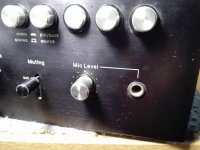
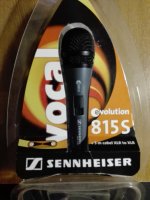

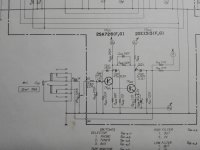
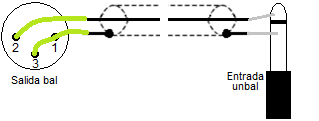
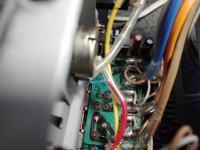
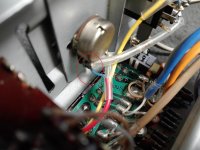
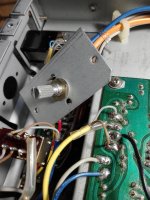
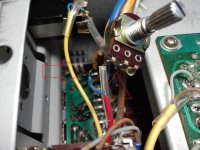
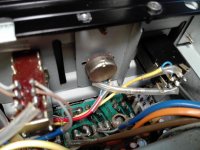
 All excuses are good, thanks friend !
All excuses are good, thanks friend !